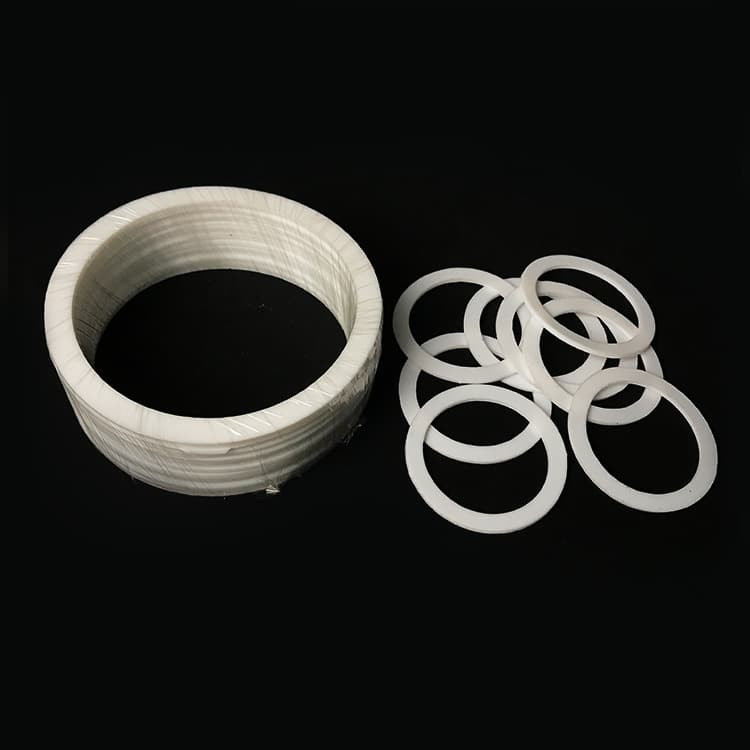At [Hengshui Hongwo Technology Co., Ltd.], we’ve spent years helping engineers and procurement teams select the right PTFE gaskets for their toughest sealing challenges. While PTFE (polytetrafluoroethylene) is known for its outstanding chemical resistance and low friction, not all PTFE gaskets are created equal.
In this guide, we’ll break down the key differences between virgin PTFE, filled PTFE, and expanded PTFE (ePTFE)—so you can make the best choice for your application.

PTFE Gaskets
1. Virgin PTFE: The Purest Form (But Not Always the Best)
When to Use It:
- Chemical resistance is critical (e.g., strong acids, caustics, solvents)
- FDA/USP Class VI compliance needed (pharmaceutical, food processing)
- Low permeation requirements (e.g., handling aggressive gases)
Limitations:
- Cold flow (creep) can cause sealing failure under constant pressure
- Poor wear resistance – not ideal for dynamic applications
- Lower mechanical strength compared to filled PTFE
Our Take:
Virgin PTFE is great for static, ultra-corrosive environments, but if you need long-term sealing under high load, consider reinforced options.
2. Filled PTFE: Enhanced Performance for Tough Conditions
Filled PTFE incorporates additives (typically 15-40%) to improve mechanical properties. Common fillers include:
| Filler Type | Key Benefits | Best For |
|---|---|---|
| Glass Fiber | Increased stiffness, reduced creep | High-pressure flanges, steam service |
| Carbon/Graphite | Better thermal conductivity, reduced wear | Heat exchangers, compressor systems |
| Bronze | Superior compressive strength | Heavy machinery, hydraulic systems |
| Molybdenum Disulfide (MoS₂) | Enhanced lubricity | Rotary seals, bearings |
When to Use Filled PTFE:
- Higher bolt loads (reduces cold flow)
- Abrasive or high-wear environments
- Thermal cycling (e.g., heat exchangers)
Our Experience:
We’ve seen glass-filled PTFE outperform virgin PTFE in steam applications by 3x in lifespan. But beware—some fillers reduce chemical resistance. Always check compatibility!
3. Expanded PTFE (ePTFE): The Flexible Problem-Solver
Unlike traditional PTFE, ePTFE is microporous, making it:
- More compressible (seals uneven surfaces better)
- Highly conformable (ideal for low-load flanges)
- Excellent for thermal insulation (lower thermal conductivity)
Best Applications:
- Irregular flange surfaces (e.g., corroded or pitted flanges)
- Low bolt torque situations (prevents gasket blowout)
- Cryogenic services (remains flexible at ultra-low temps)
Our Warning:
While ePTFE is great for sealing, it’s not for high-pressure systems (>300 psi). We’ve seen failures where users pushed beyond its limits.
4. How to Choose the Right PTFE Gasket for Your Application
Decision Checklist:
✅ Chemical Exposure? → Virgin PTFE (if pure resistance needed)
✅ High Pressure/Temperature? → Glass or carbon-filled PTFE
✅ Uneven Flanges? → ePTFE for better sealing
✅ FDA Compliance? → Virgin PTFE (no fillers)
Our Recommendation:
If you’re unsure, ask us for a material test report. We’ve helped dozens of plants avoid costly failures by matching the right PTFE grade to their exact conditions.
5. Common Mistakes Buyers Make (And How to Avoid Them)
Mistake #1: Assuming All PTFE Is the Same
- Reality: Fillers drastically change performance. A bronze-filled PTFE gasket will fail in hydrofluoric acid, while virgin PTFE excels.
Mistake #2: Ignoring Bolt Load Requirements
- Our Fix: Always check ASME PCC-1 torque specs. Under-torquing causes leaks; over-torquing crushes PTFE.
Mistake #3: Not Considering Long-Term Creep
- Solution: For permanent seals, use filled PTFE or add reinforcing rings.
Final Thoughts: Why We Prefer Filled PTFE for Most Industrial Uses
While virgin PTFE is the gold standard for chemical resistance, we’ve found that most industrial applications benefit more from filled PTFE. The added strength and creep resistance often justify the small trade-off in purity.
Need Help Selecting?
Our engineers are ready to review your specs and recommend the best PTFE gasket—whether it’s virgin, filled, or expanded. Contact us today for a free consultation.
Why Trust Us?
- 20+ years in sealing solutions
- Tested in refineries, chemical plants, and pharma facilities
- No sales fluff – just real-world performance data
Still unsure? Download our free PTFE Selection Checklist to make the right choice.
This guide reflects our hands-on experience—not just textbook theory. Let us help you avoid costly mistakes. 🚀
 Hongwo Sealing Gasket
Hongwo Sealing Gasket


WhatsApp
Scan the QR Code to start a WhatsApp chat with us.